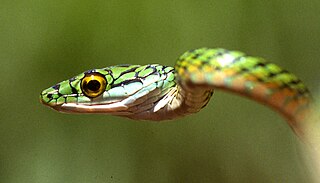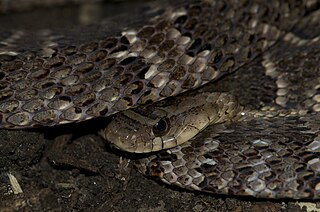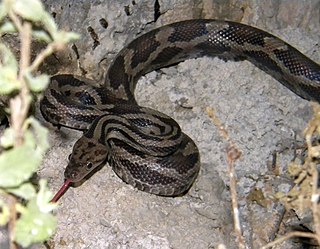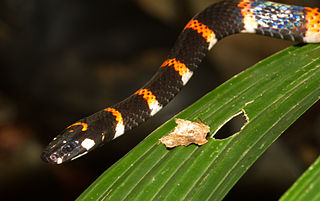
Leptophis ahaetulla, commonly known as the lora or parrot snake, is a species of medium-sized slender snake of the family Colubridae. The species is native to Central America and northern South America.
Atractus trilineatus, commonly known as the three-lined ground snake, is a species of small burrowing snake in the family Colubridae. The species is native to South America.

Erythrolamprus cobella, commonly known as the mangrove snake, is a species of small semi-aquatic snake, which is endemic to South America.
Karl Hoffmann was a German physician and naturalist.

Drymobius margaritiferus, commonly known as the speckled racer, is a species of nonvenomous colubrid snake native to the Americas. The specific name, margaritiferus, means "pearl-bearing" in Latin, referring to the pearl-like spots on the dorsal scales.

Geophis is a genus of snakes in the subfamily Dipsadinae of the family Colubridae of the superfamily Colubroidea. Species in the genus Geophis are commonly referred to as Latin American earth snakes. The genus consists of 53 distinct species.

Xenodon rabdocephalus, commonly known as the false fer-de-lance, is a species of mildly venomous rear-fanged snake in the family Colubridae. The species is native to Central America and northern South America. There are two recognized subspecies.

The yellow-red rat snake is a species of snake in the family Colubridae. The species is endemic to Mexico and Central America. Three subspecies are recognized.

The olive marsh snake is a species of snake in the subfamily Natricinae of the family Colubridae. The species is endemic to Sub-Saharan Africa.

Pliocercus euryzonus, commonly known as Cope's false coral snake, is a species of snake in the subfamily Dipsadinae of the family Colubridae. The species is indigenous to southeastern Central America and northwestern South America. There are two recognized subspecies.
Hydromorphus is a genus of snakes in the subfamily Dipsadinae.

The Colombian longtail snake, also known commonly as the sock-headed snake and the white-headed snake, is a species of snake in the family Colubridae. The species, which is monotypic in the genus Enuliophis, is native to Central America and northern South America.

Geophis dunni, Dunn's earth snake, is a species of enigmatic snake in the family Colubridae. The species is presumably endemic to Nicaragua and is only known from a single specimen discovered in 1932. This specimen, the holotype, was discovered by Karl Patterson Schmidt in the stomach of a Central American coral snake, and no additional specimen has been seen since. The holotype has a snout-to-vent length (SVL) of 310 mm (12 in), a tail length of 57 mm (2.2 in), and a total length of 367 mm (14.4 in). It is part of the Geophis sieboldi species group according to Floyd Leslie Downs. This species was named by Schmidt after fellow herpetologist Emmett Reid Dunn "in allusion to his important contributions to our knowledge of this group of snakes".
Geophis championi, the Panamenian earth snake, is a species of snake in the family Colubridae. The species is endemic to Panama.

Atractus emmeli, also known commonly as Emmel's ground snake and Boettger's ground snake, is a species of snake in the family Colubridae. The species is native to northwestern South America.
Atractus guentheri, also known commonly as Günther's ground snake and coral-falsa in Brazilian Portuguese, is a species of snake in the subfamily Dipsadinae of the family Colubridae. The species is endemic to Brazil.
Geophis godmani, also known commonly as Godman's earth snake, the yellow-bellied earth snake, and la culebra minadora de Godman in American Spanish, is a species of snake in the Family Colubridae. The species is native to Central America.

Geophis sartorii, also known commonly as Sartorius' snail-sucker and the terrestrial snail sucker, is a species of snake in the family Colubridae. The species is native to southern North America and Central America. There are two recognized subspecies.
Urotheca guentheri, also known commonly as Günther's graceful brown snake and the striped glasstail, is a species of snake in the family Colubridae. The species is native to Central America.
Urotheca myersi is a species of snake in the subfamily Dipsadinae of the family Colubridae. The species is endemic to Costa Rica.












